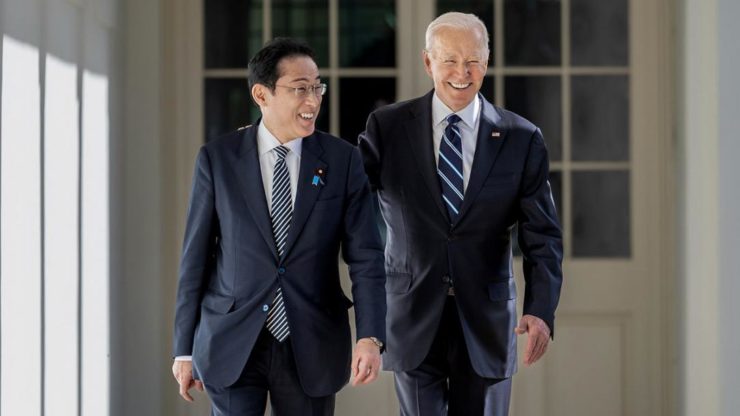
The ongoing upgrades to the US-Japan military cooperation signals new regional developments. In reality, however, this upgrade is a continuation of the US strategy in the Pacific to build military outposts so that China can be deterred and tackled. On the one hand, it is militarizing Japan. On the other hand, the sale of weapons keeps bringing money to the US military-industrial complex. Ultimately, this alliance will do little to serve the purpose of ‘containing’ China. Most of the equipment the US is providing is outdated, basically getting rid of the scrap. The modern equipment, on the other hand, is unreliable. Still, Trump’s arrival in the White House could change the dynamics of military cooperation, making things worse.
The Upgrades:
Following the announcements made during the Biden-Kishida summit in April regarding big upgrades to the US-Japan alliance, the upgrade has finally arrived. On the 3rd of July, the Pentagon announced that the US was going to upgrade “tactical aircraft laydown across multiple military installations in Japan”. This so-called “modernization plan” is worth US$ 10 billion that will “bolster regional deterrence, and strengthen peace and stability in the Indo-Pacific region”. According to the announcement, the US will replace 48 F-15C/D with 36 F-15EX fighters at Kadena Air Base. The US Air Force will also replace 36 F-16 aircraft with 48 F-35A aircraft at Misawa Air Base. Overall, the plan to “station the Joint Force’s most advanced tactical aircraft in Japan demonstrates the ironclad U.S. commitment to the defence of Japan and both countries’ shared vision of a free and open Indo-Pacific region”. In addition to these new deployments, NATO is also in the middle of releasing its new policy documents outlining its new lines of cooperation with countries like Japan, Australia, New Zealand, and South Korea. There seems to be momentum, but it will soon run into problems that it may not be able to recover from.
Can US-Japan-NATO Counter China?
While the F-15EX seems like a significant upgrade from the outdated F-15C/Ds, they are still no match against China’s growing fleet of stealth fighter jets. It means that were Japan to use these fighters in an offensive against China, they would prove useless since they lack stealth features and would be unable to penetrate a heavily guarded airspace.
While the deployment of F-35 jets does mark a significant upgrade, there are serious questions about its operational and logistic utility, compromising its ability to tackle China’s J-20s. In 2023, according to one estimate, China produced 100 J-20. If China can maintain the same rate, it will have 1,000 J-20s by 2035. The US has less than F-22s, and its F-35 programme continues to run into problems.
The 2023 Annual Report by the Director, Operational Test and Evaluation made some startling observations, saying,
“The F-35 program development cycle continues to experience delays due to immature and deficient Block 4 mission systems software and avionics stability problems with the new Technology Refresh 3 (TR-3) hardware going into Lot 15 production aircraft. As a result, deliveries of production Lot 15 aircraft in the TR-3 configuration are on hold until more testing can be completed and the avionics issues resolved. Additionally, these delays prevented the F-35 Joint Program Office (JPO) from adequately planning and programming for hardware modifications for OT of the upgraded hardware configuration”.
As a result of these delays and difficulties, only 32 out of 205 baseline DT flights were conducted. The US is now stationing the F-35s in Japan, which basically relies on the assumption that these delays will ultimately be resolved and that Washington will not have to move these F-35s to a different location to meet the recurring shortages. But the reality is that, as the report concludes, “The operational suitability of the F-35 fleet remains below Service expectations and requirements”, which means that, according to the report, out of 628 aircraft produced until now, a majority of them remain “unavailable” for active service throughout most of the year. In fact, 2023 had fewer available aircraft than 2022. What this ‘upgrade’ will do to Japan’s security is, therefore, not hard to imagine. In the end, other than creating a false sense of security, it might not add any value to Japan’s offensive and defensive capabilities, compromising the politics of ‘China containment’.
The Trump Factor
Former US President Donald Trump’s return to the White House next year is already making Washington’s European allies extremely uneasy. Whereas Trump has thus far signalled that his administration will ideally continue to follow the Biden administration’s policy towards Japan and China, Trump has also assured his voters of the continuation of his “America First” and “Make America Great Again” policies, which also involve, among other things, military disengagements.
Therefore, the existing rhetoric of reassurance notwithstanding, Trump’s politics and/or his geopolitical vision has not seen any change in the recent past. Reports in the US media indicate that “a second Trump administration is likely to be far more disruptive for Asia than the first one was”. What it implies is that, with Trump forcing the US military footprint to reduce worldwide, countries like Japan will need to find ways to become self-reliant. So, instead of depending upon the actual supply and availability of otherwise “unavailable” fifth-generation jets, Tokyo will need to develop an alternative, more reliable strategy – a strategy that should not exclude the possibility of dialogue with China to sort out any existing issues without any external interference.
In fact, since Trump is likely to target China and push the US away from Japan’s military build-up, he is likely to antagonise both states. There is, therefore, an incentive for both Asian giants to collaborate and find peace.
Salman Rafi Sheikh, research analyst of International Relations and Pakistan’s foreign and domestic affairs, exclusively for the online magazine “New Eastern Outlook”.
